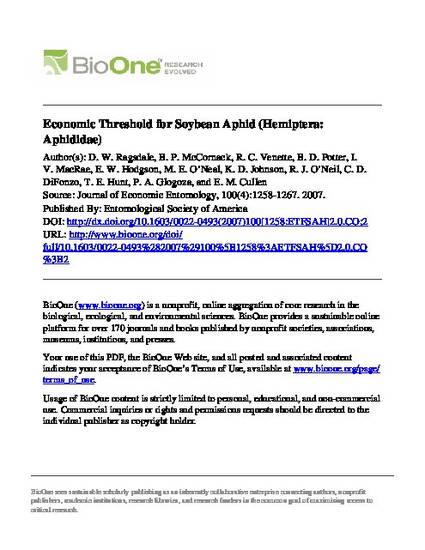
Soybean aphid, Aphis glycines Matsumura (Hemiptera: Aphididae), reached damaging levels in 2003 and 2005 in soybean, Glycine max(L.) Merrill, in most northern U.S. states and Canadian provinces, and it has become one of the most important pests of soybean throughout the North Central region. A common experimental protocol was adopted by participants in six states who provided data from 19 yield-loss experiments conducted over a 3-yr period. Population doubling times for field populations of soybean aphid averaged 6.8 d ± 0.8 d (mean ± SEM). The average economic threshold (ET) over all control costs, market values, and yield was 273 ± 38 (mean ± 95% confidence interval [CI], range 111–567) aphids per plant. This ET provides a 7-d lead time before aphid populations are expected to exceed the economic injury level (EIL) of 674 ± 95 (mean ± 95% CI, range 275–1,399) aphids per plant. Peak aphid density in 18 of the 19 location-years occurred during soybean growth stages R3 (beginning pod formation) to R5 (full size pod) with a single data set having aphid populations peaking at R6 (full size green seed). The ET developed here is strongly supported through soybean growth stage R5. Setting an ET at lower aphid densities increases the risk to producers by treating an aphid population that is growing too slowly to exceed the EIL in 7 d, eliminates generalist predators, and exposes a larger portion of the soybean aphid population to selection by insecticides, which could lead to development of insecticide resistance.
Available at: http://works.bepress.com/erin_hodgson/54/

This article is from Journal of Economic Entomology, 100(4):1258-1267. 2007 doi: 10.1603/0022-0493(2007)100[1258:ETFSAH]2.0.CO;2